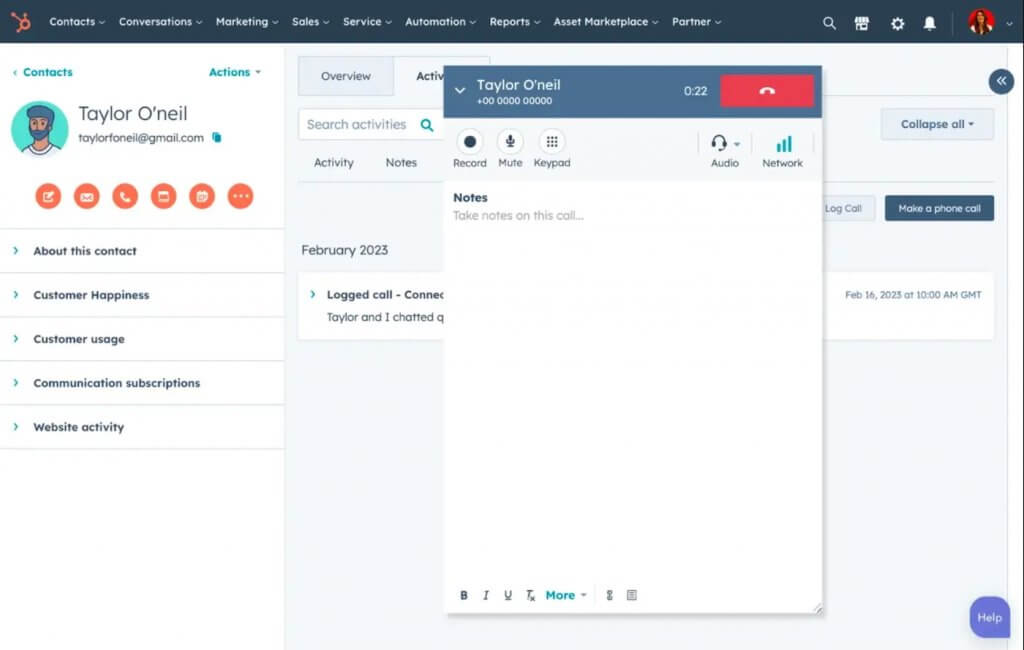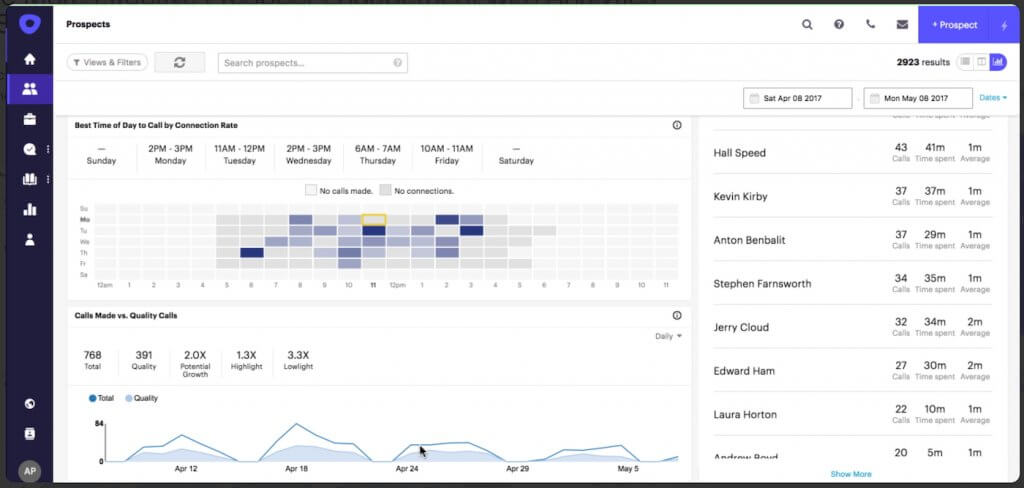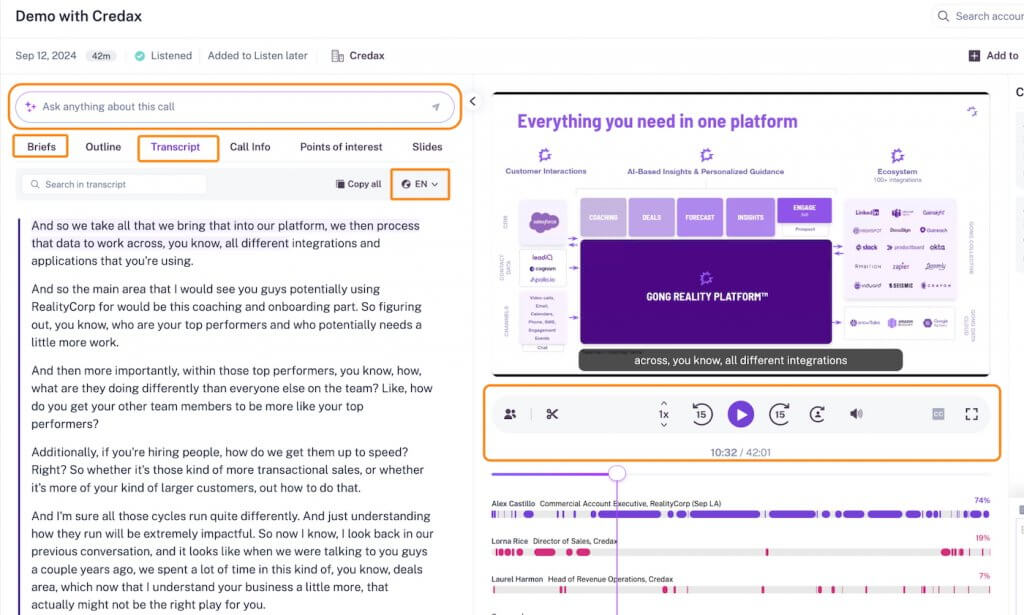-
News & Trends -
Sales -
Marketing Related Topics -
B2B Software Guides Related Topics -
Free Tools & Resources -
- About Us About Us
Outbound sales calls can feel like walking a tightrope because you’ve only got a few seconds to earn attention, spark curiosity, and keep the conversation moving. The right outbound sales script can make all the difference in getting hung up on and booking a meeting.
I’ve seen that play out in my own results. When I lead with a strong, authentic opening and a clear value hook, people listen. That’s why, in this guide, I’m sharing the outbound call scripts that actually work for me — from cold introductions to follow-ups and re-engagement calls that revive old leads.
I’ll break down why each script works, how I adjust my approach for different buyers, and some hard-earned lessons from real calls that turned into deals. By the end, you’ll have cold call script examples you can make your own to help you sound confident, stay authentic, and get more prospects talking.
Cold calls are among the toughest to master because you’re reaching out uninvited. This script focuses on earning permission before pitching to create a respectful, low-pressure first impression. It works best for top-of-funnel outreach where the goal is simply to start a conversation, not close a deal.
Script:
“Hey , this is with . I know I’m calling out of the blue, but do you mind if I take 30 seconds to tell you why I’m reaching out? If it’s not relevant, you can hang up.”
“I’ve been talking with who’ve been trying to . We help them . Does that sound familiar on your end?”
Why it works: This is one of the cold call script examples that gives the prospect control and builds trust quickly. The 30-second permission-based ask disarms tension while proving respect for their time.
Despite the rise of emails, LinkedIn messages, and social outreach, recent research shows that the phone remains one of the strongest channels for outbound pipeline. In fact, 51% of pipeline deals still come from calls, and 86% of teams say it’s their best channel.
Another study by HubSpot and Aircall echoed these findings, ranking the phone as the second most effective sales tool, right behind in-person meetings.
Follow-up calls are where consistency turns into results. By tying your outreach back to a prior message or touchpoint, you instantly build familiarity and trust. This script bridges digital communication and live dialogue, helping move leads from awareness to genuine engagement.
Script:
“Hey , it’s from . I sent an email last week about . I just wanted to put a voice to the name and see if you had a quick minute to chat about it.
We’ve helped , and I thought it might be worth seeing if it’s relevant for your team too.”
Why it works: This call script for outbound calls connects to a familiar touchpoint and reinforces credibility. The phrase “put a voice to the name” makes the call feel more human and less pushy.
Warm calls rely on curiosity and timing. Since your prospect already knows who you are, focus on understanding why they’re interested. This sales call script sample starts with an open-ended question that gives control back to the buyer.
Script:
“Hey , I saw you checked out our . I appreciate you taking a look. What caught your eye?
A lot of teams reach out when they’re trying to . Is that something you’re focused on right now?”
Why it works: This permission-based opener starts with curiosity and gives control back to the buyer. This type of opener is a proven way to increase engagement with warmer leads.
Re-engagement calls offer a second shot at leads that went cold. This script acknowledges prior contact while introducing something new, such as a product update, success story, or fresh value proposition.
It’s ideal for rebuilding momentum with past prospects who may be ready to revisit the conversation.
Script:
“Hey , it’s from . We talked a while back about . I know the timing wasn’t right then, but I wanted to share something new that’s been helping teams like yours .
Would it make sense to revisit this for 10 to 15 minutes?”
Why it works: This call center outbound calls script acknowledges the past without pressure. Framing the outreach around “something new” sparks curiosity and relevance.
Referral calls tend to convert faster because trust is built in. This script leans on the credibility of a mutual contact, helping you bypass skepticism and open the conversation from a place of familiarity. It’s perfect for relationship-based selling or partnership outreach.
Script:
“Hi , suggested I give you a call because they thought it might make sense for us to connect. I work with teams on . Does that align with what you’re focused on right now?”
Why it works: Referrals open doors faster. The connection name builds instant credibility while keeping the tone light and approachable.
Since most prospects won’t answer an unfamiliar number, your voicemail becomes your first impression. This short, value-driven script sparks curiosity and directs attention to your follow-up email, giving your outreach a one-two punch that increases response rates.
Script:
“Hey , it’s with . I had a quick idea that could help with . I’ll send you a short note with some context; it’s from . Talk soon.”
Why it works: It keeps voicemail under 15 seconds, piques curiosity, and creates anticipation for your follow-up message.
Objections are opportunities in disguise because they signal interest wrapped in hesitation. These mini scripts help you respond with empathy, keep the tone conversational, and pivot smoothly back to value. Mastering them turns tense moments into relationship-builders.
“I totally get it. Sounds like I caught you at a bad time. When’s usually better for a quick five-minute call?”
“Of course. I’ll send that over. Just so I include the right info, what specifically caught your interest?”
“Makes sense. A lot of teams I talk to are using too. I’m curious, what do you like most about them?”
Why it works: Each of these cold call script examples acknowledges the objection and gently reopens the dialogue, showing empathy and confidence.
Every successful call ends with a clear, confident next step. This script helps you lock in a meeting or demo by framing the close around collaboration and mutual benefit. It helps you transition naturally from rapport to action without sounding pushy.
Script:
“Sounds like this could be worth exploring. How’s your calendar looking for a 20-minute call later this week? I can share a few ideas specific to your team.”
Why it works: An assumptive close framed around value, not commitment. It feels collaborative rather than salesy.
A great outbound sales script feels like a confident, relevant conversation rather than a memorized pitch. The best reps use scripts as flexible frameworks, not rigid lines, so they can adapt naturally while keeping the call focused on the next step.
To write a truly effective script, it’s important to understand the psychology behind cold calling and how pattern interrupts and personalization grab attention. You also need to master the core elements that make a script flow naturally from opener to close and apply techniques that help you sound conversational instead of robotic.
When you call someone unexpectedly, their instinct is often to shut down or disengage. To overcome that, you need a pattern interrupt. This is a technique that uses something that surprises the prospect just enough to make them listen.
Gong.io’s analysis of more than 300 million sales calls revealed that permission-based openers achieved an 11.18% success rate. These openers function as pattern interrupts by surprising the prospect and giving them control, which helps them outperform traditional cold-call openings.
A friendly tone, a quick acknowledgement (“I know I’m calling out of the blue”), or a thoughtful question about their business can shift their mindset from defense to curiosity. From there, personalization keeps the momentum going.
Reference a relevant role, challenge, or company event to prove you’ve done your homework. A survey by Attentive found that 81% of consumers ignore irrelevant marketing messages, and 96% say they’re likely to purchase when brands send personalized messages. One great idea is to use strategic compliments or flattery in your personalization strategy.
An effective outbound script follows a simple flow that keeps the conversation natural while moving it toward a clear next step. Here are the core elements every high-performing script should include.
The first 10 seconds make or break your call. Start with a line that earns permission to continue. This opener disarms prospects by giving them control. Permission-based openers far outperform weaker openers, like “Did I catch you at a bad time?” For example:
“Hey [Name], I know I’m calling out of the blue. Do you mind if I take 30 seconds to share why I reached out?”
Once you’ve got their attention, clearly communicate what you can help them achieve. Keep it simple and outcome-focused. Avoid features and lead with results. Here’s an example:
“We help [role or company type] [achieve specific results, like cutting admin time by 25% or boosting lead quality].”
Good calls are two-way conversations. Ask open-ended questions that uncover pain points and priorities. These questions invite the buyer to share, helping you tailor your pitch in real time. For example:
“How are you currently handling [process or challenge]?”
Objections are part of the sales process, so you have to expect them. The best reps acknowledge them, then pivot to keep the conversation alive. This example shows empathy first before presenting a solution:
“I totally understand. Many of the people I talk to feel the same way at first, until they see how easy it is to [achieve result].”
End every call with a clear, easy next step, such as a demo, a meeting, or a quick follow-up. A confident, collaborative close like this example makes the transition feel natural rather than pushy:
“How’s your calendar later this week for a 15-minute chat to see if this might be a fit?”
Even the best script can fall flat if it sounds stiff or rehearsed. These tips can help you deliver your message naturally, so every call feels like a genuine conversation rather than a sales pitch.
Having the right tools can make your outbound calls more consistent, personalized, and measurable. The platforms below help you script smarter, track performance, and continuously refine your approach based on real call data.
HubSpot offers built-in calling with the ability to store scripts inside the CRM, attach them to sequences, and use them during live calls. It automatically tracks call outcomes, logs notes, and surfaces performance metrics like call volume, meeting rates, and rep productivity, making it easy to optimize scripts over time.

Outreach.io helps reps build consistent call workflows by storing customizable call scripts directly inside sequences and task flows. It also tracks call outcomes, logs activity automatically, and provides analytics, such as connect rate, call duration, and conversation trends to improve future outreach.

Gong.io records and transcribes sales calls, then uses AI to analyze talk-to-listen ratios, opener effectiveness, objection handling, and next-step clarity.
It’s especially valuable for refining scripts because it identifies patterns in top-performing calls and shows which phrasing and approaches drive the highest conversion.

Begin your outbound call by introducing yourself confidently and earning permission to continue. A simple, effective opener is: “Hi [Name], this is [Your Name] with [Company]. I know I’m calling out of the blue. Do you mind if I take 30 seconds to tell you why I’m reaching out?” This approach shows respect for the prospect’s time while setting a conversational tone. Follow immediately with a short, value-driven statement that connects to their role or challenge to spark interest and keep the call moving naturally.
The average length of a successful cold call is about five minutes. In general, the sweet spot for most outbound calls falls between two and five minutes. This amount of time should be long enough to build rapport, uncover a prospect’s needs, and earn a next step, but short enough to keep their attention.
Research your prospect before calling. Look at their LinkedIn activity, company news, or recent product launches. Mention something relevant in your opener, like “I saw you recently expanded your sales team. Are you focused on scaling lead volume right now?” Personalized calls convert significantly better than generic ones.
The key is to acknowledge and redirect. When a prospect says, “I’m busy,” reply with, “I totally get it. When’s usually a better time for a quick chat?” This acknowledgment keeps the tone collaborative and helps you stay in control of the next step.
To measure success with outbound calls, track metrics like connect rate, meeting-booked rate, and call-to-conversion ratio. High-performing teams also analyze the talk-to-listen ratio and use call recordings to refine messaging and tone continuously.
Outbound sales calls still work when you lead with value, authenticity, and a clear purpose. The right script sparks real conversations that move prospects forward. Use these outbound sales call script examples as a framework, then personalize them for your audience, and you’ll turn more cold calls into genuine opportunities.

Selling Signals delivers actionable advice for sales and marketing professionals. Learn strategies that help you hit targets, strengthen customer relationships, and win more business. Get expert advice on lead generation, sales processes, CRM software, sales management, and account management directly to your inbox.
Property of TechnologyAdvice. © 2025 TechnologyAdvice. All Rights Reserved
Advertiser Disclosure: Some of the products that appear on this site are from companies from which TechnologyAdvice receives compensation. This compensation may impact how and where products appear on this site including, for example, the order in which they appear. TechnologyAdvice does not include all companies or all types of products available in the marketplace.